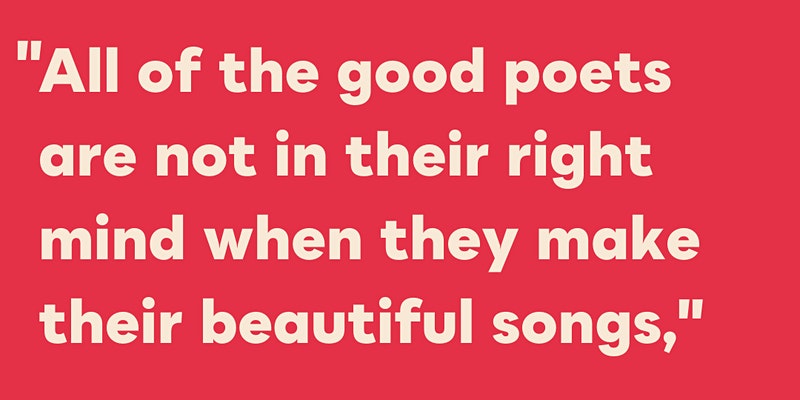By Jenna Macrory, Creative Producer of Creative Spaces

The stereotype of the tortured artist is ingrained in Western culture. With this trope remaining so pervasive for such a length of time the archetype of the tortured artist has adapted with society over time. With the societal perception of mental illness changing, how has the relationship between creativity and suffering progressed over time?
Historically, mental illness and creativity have always been closely associated. In ancient Greece, madness was perceived as a state of other-worldliness. Madness to the Greeks could be interpreted in two ways: divine or demonic.* Demonic madness was seen as bad and therefore perceived in a negative light similar to how mental health is often stigmatised today.
Conversely, divine madness is a spiritual pursuit that permits an individual to act out with conventional societal standards. For the ancient Greeks, creativity was derived from this subversion of social norms. In other words, creativity comes from madness, albeit a specific type of madness but for numerous centuries creativity and madness have remained intertwined.
Few things have remained as prominent through human history as the trope of the tortured artist. Spanning centuries and infecting every single medium of art, prominent creatives appear to use suffering to their advantage.
Author Sylvia Plath channelled her depression into her only novel The Bell Jar; Louis Wain’s paintings of anthropomorphic cats transformed into psychedelic subjects upon his descent into schizophrenia; Kurt Cobain publicly professed his battles with mental health through many of his songs. The list of creatives battling with mental illness goes on but this alludes to a link between creativity and mental health particularly considering that this trope has remained over centuries.
As such a culturally pervasive topic, recent decades have seen the rise of studies investigating mental health in creatives. Despite the empirical evidence of a link between creativity and mental disorders, several studies have exhibited little to no link between the two.
Creative professions proved no more likely to suffer from psychiatric disorders according to a study involving 1.2 million Swedish citizens.** Contrarily studies that do exhibit higher rates of mental disorders show only a marginal difference.*** With the link between creativity and mental illness seeming arbitrary, why has the archetype of the tortured artist remained?
Although creativity itself does not correlate with mental wellbeing, many artists find themselves in conditions that allow psychiatric disorders to manifest. A passion to create leads many artists into situations that can be mentally straining such as low-paying career paths, job instability, or substance abuse.
This sentiment is reinforced by figures suggesting that as many as 60 percent of workers in creative industries spoke of having suicidal thoughts. Although the sole act of being creative does not denote an individual to madness, the environment and social networks we are part of contribute to our psychological wellbeing.
While the tortured artist trope was conceived from the concept of a suffering introspective soul, recent years have seen the narrative of this trope shift. The tortured artist is no longer tormented by an inward pain, the suffering of an artist is now amplified by an economic climate that makes living as an artist increasingly difficult.
Despite this shift, the stereotype of the tortured artist will remain although as we continue to witness the gradual destigmatisation of mental health we can address the issues at the core of this trope. As a result, we can begin to move away from this romanticised image of the tortured artist toward a healthier stereotype.
As humanity progresses how will the tortured artist stereotype change? How will changes to the wider society impact on this persona? Will the art economy, already struggling in a post pandemic world plunge more creatives into mental instability?
If you have any thoughts on these and you are under 30 you can join Creative Spaces for our conversation around the tortured artist persona at 7pm, 8th July. For more information and to book a space please click the link below:
The Tortured Artist Stereotype: An Open Conversation
* John Matthews, Creativity and Mental Illness: Exploring the ‘Tortured Artist’, https://www.vacounseling.com/tortured-artist/.
** Simon Kyaga, Mikael Landen, Marcus Boman, Christina M Hultman, Niklas Langstrom, Paul Lichtenstein, Mental illness, suicide and creativity: 40-year prospective total population study, https://pubmed.ncbi.nlm.nih.gov/23063328/.
*** Stephen A. Stansfeld, Jenny Head, Farhat Rasul, Occupation and mental health: Secondary analyses of the ONS Psychiatric Morbidity Survey of Great Britain, https://www.hse.gov.uk/research/rrpdf/rr168.pdf.
